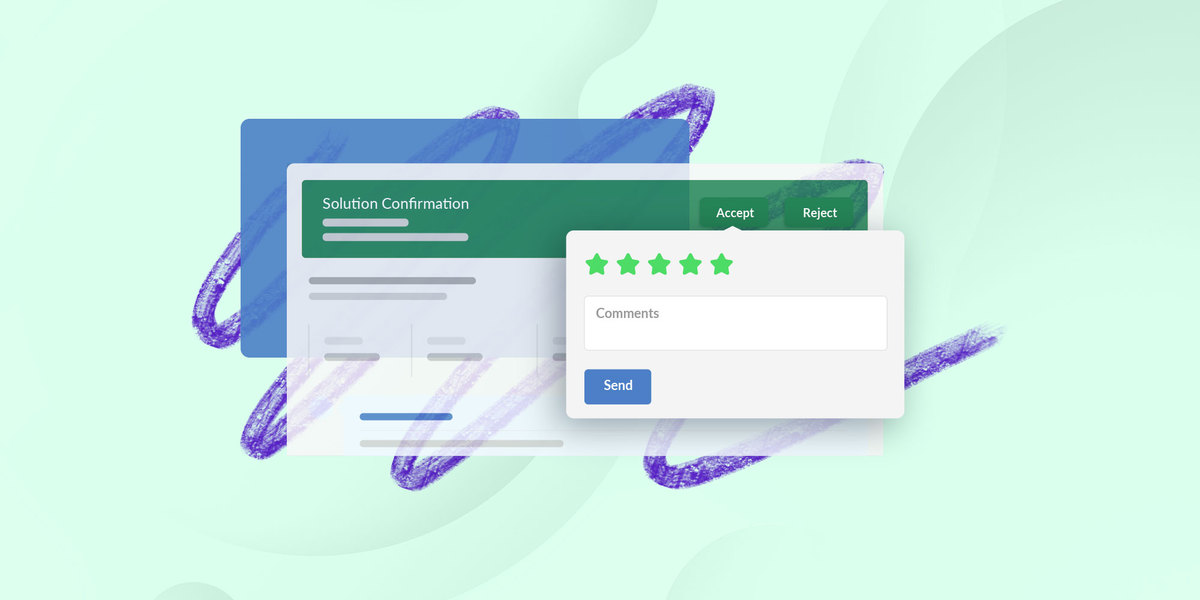If you’ve ever wondered how happy your customers truly are, you’re in the right place. It turns out there is an easy and approachable way to measure it: the CSAT or Customer Satisfaction Score, which specifically measures customer satisfaction related to a product or service.
It’s a delightful little metric that helps businesses like yours tap into the hearts and minds of their clientele. Imagine being able to gauge customer happiness with just a few simple questions!In this article, we’ll embark on a journey to explore the ins and outs of CSAT. We’ll break down what it is, how to calculate it, and when to use it, all while keeping things light and engaging. Along the way, we’ll weigh the pros and cons, compare it to other important metrics like NPS and CES, and even provide a real-world example to illustrate its impact.
So, let’s dive in and discover how CSAT can transform your approach to customer feedback and help you create happier, more loyal customers!

What is CSAT (Customer Satisfaction Score)?
CSAT is a metric that measures customer satisfaction with a company’s products, services, or interactions. It is typically assessed through a simple survey question like: How satisfied were you with your experience? Customers respond using a scale, often ranging from 1 to 5 or, in some cases, 1 to 10.
The primary goal of the score is to collect feedback that can provide insights into areas for improvement. By regularly measuring it, businesses can track changes in customer satisfaction over time and identify potential issues that could lead to customer churn.

Key aspects of CSAT as a key performance indicator
-
Simplicity: CSAT surveys are very straightforward, making it easy for customers to provide feedback.
-
Flexibility: The scoring system can be tailored to fit the context, whether through numeric ratings, star ratings, or emojis.
-
Timeliness: CSAT can be measured immediately after a specific interaction, providing real-time insights into customer satisfaction.
CSAT pros and cons
Understanding the advantages and disadvantages of CSAT can help businesses make informed decisions about its use in measuring customer satisfaction.
Pros of CSAT
-
Easy to implement: CSAT surveys are quick to set up and don't require extensive resources.
-
High response rates: Due to their simplicity, CSAT surveys often achieve higher response rates compared to other survey types.
-
Immediate feedback: the score provides real-time insights, allowing businesses to address issues promptly.
-
Actionable insights: The data collected can highlight specific areas for improvement, guiding businesses on where to focus their efforts. Identifying unhappy customers allow businesses to address issues proactively and improve retention rates.
Cons of CSAT
-
Short-term focus: CSAT primarily reflects customer satisfaction at a specific moment, which may not represent long-term loyalty.
-
Cultural bias: Responses can vary significantly across different cultures, potentially skewing results.
-
Limited scope: CSAT may not capture the full customer experience, as it often focuses on individual interactions rather than the entire customer journey.
-
Ambiguity in scores: What constitutes a “good” or “bad” score can vary widely across industries, making it challenging to benchmark effectively.

The actual scale of CSAT
When measuring Customer Satisfaction Score, businesses typically use a scale that allows customers to express their satisfaction levels clearly. In most cases, the journey begin with a customer satisfaction survey. The most common scale is a 1 to 5 Likert scale, which includes the following ratings:
-
Very unsatisfied: This rating indicates that the customer had a significantly negative experience. They likely faced issues that were not resolved, leading to frustration and disappointment.
-
Unsatisfied: Customers who select this rating felt their experience was below expectations. They may have encountered some problems, but perhaps not as severe as those who rated their experience as “Very Unsatisfied.”
-
Neutral: A neutral rating suggests that the customer neither felt particularly satisfied nor dissatisfied. This could mean their experience was average or that they had mixed feelings about the service or product.
-
Satisfied: Customers who rate their experience as “Satisfied” had a positive interaction. They found the service or product met their expectations, and they left feeling content.
-
Very satisfied: This is the highest rating, indicating that the customer had an exceptional experience. They felt that their needs were fully met, and they are likely to return or recommend the service to others.
The results from these ratings can be averaged out to provide a Composite Customer Satisfaction Score, often expressed as a percentage. For example, if 80% of respondents rated their experience as either “Satisfied” or “Very Satisfied,” the CSAT score would be 80%.
CSAT calculation: Step-by-step guide
Calculating CSAT is a straightforward process that involves a few simple steps. We summarize them in three easy steps:
-
Collect responses: Gather customer feedback through customer satisfaction surveys after interactions, purchases, or service experiences.
-
Count positive responses: Tally the number of positive ratings (for example, ratings of 4 or 5 on a 5-point scale).
-
Calculate the CSAT Score Use the formula: (Number of Satisfied Customers -4 and 5 ratings- / total responses) x 100. So, let’s say that you you received 100 responses. 60 rated 5 (Very Satisfied); 20 rated 4 (Satisfied); 10 rated 3 (Neutral); 5 rated 2 (Dissatisfied); and 5 rated 1 (Very Dissatisfied). The calculation is very simple: (60 + 20) / 100) * 100 = 80%.
-
Analyze results: Use the CSAT score to identify trends and areas needing improvement.
Practice example of CSAT
Let’s dive into a real example. To illustrate how CSAT works in a real-world scenario, let’s consider a fictional online retail company, “ShopSmart.”
After a customer makes a purchase, they receive a follow-up email asking them to rate their satisfaction with the shopping experience. Meeting customers' expectations is crucial for achieving high CSAT scores, as it directly impacts their satisfaction with the shopping experience. The survey question might read: “How satisfied were you with your shopping experience at ShopSmart?”. Using the 1 to 5 scale, the customer selects a rating. Here’s how the process unfolds:
1. Survey distribution: After a purchase, ShopSmart sends out a CSAT survey via email. The survey is brief, consisting of the satisfaction question and an optional comment box for additional feedback.
2. Customer responses: Over a week, ShopSmart collects responses from 200 customers. The ratings are as follows:
-
1 (Very Unsatisfied): 10 responses
-
2 (Unsatisfied): 20 responses
-
3 (Neutral): 30 responses
-
4 (Satisfied): 80 responses
-
5 (Very Satisfied): 60 responses
3. Calculating the CSAT Score: To calculate the CSAT score, ShopSmart focuses on the positive responses (ratings of 4 and 5). The calculation would be:
CSAT Score = (Number of Positive Responses / Total Responses) x 100
Plugging in the numbers:
CSAT Score = (80+60) / 200) x 100 = (140200) x 100 = 70%.
4. Analyzing the results: With a CSAT score of 70%, ShopSmart recognizes that while a majority of customers are satisfied, there is room for continuous improvement. The company reviews the comments provided by customers who rated their experience as “Unsatisfied” or “Very Unsatisfied.”
5. Taking action: Based on the feedback, ShopSmart identifies key areas for improvement, such as enhancing the website’s navigation and addressing shipping delays. They implement changes and plan to conduct another CSAT survey after a few months to measure the impact of these improvements.
This example demonstrates how CSAT can be a powerful tool for businesses to gauge customer satisfaction, identify areas for enhancement, and ultimately improve the customer experience.
What is a good CSAT score?
A “good” CSAT score can vary depending on the industry, but generally, the following benchmarks apply for this key performance indicator:
-
Below 50%: Indicates poor customer satisfaction and immediate action is needed.
-
50% to 70%: Reflects average satisfaction; there’s room for improvement.
-
70% to 90%: Represents good customer satisfaction and engagement.
-
Above 90%: Indicates exceptional satisfaction, suggesting strong loyalty and positive experiences.
It’s essential to compare your CSAT score against industry standards to gauge performance accurately.
When should you use CSAT for customer feedback?
CSAT is most effective when measuring customer satisfaction in specific interactions or experiences. Here are some ideal use cases:
-
Post-purchase surveys: Gauge customer satisfaction immediately after a transaction.
-
After customer support interactions: Measure satisfaction following a service call or support ticket resolution.
-
During customer journey milestones: Assess satisfaction at key points in the customer lifecycle, such as onboarding or product usage.
Using CSAT at these critical touchpoints can provide valuable insights into customer experiences, help identify areas for improvement and enhance customer retention.
Difference Between CSAT, NPS, and CES
While CSAT, NPS, and CES all measure aspects of customer experience, they focus on different elements:
-
CSAT (Customer Satisfaction Score): CSAT measures customer satisfaction with specific interactions or experiences.
-
NPS (Net Promoter Score): Assesses overall customer loyalty and likelihood to recommend the company or product.
-
CES (Customer Effort Score): Evaluates the ease with which customers can complete a task or resolve an issue.
Understanding these differences can help businesses choose the right metric for their needs.
Unlocking Experience Management
Discover how the experience you deliver can make or break your success.
Download for free
In conclusion
In the ever-evolving landscape of customer experience, CSAT stands out as a vital tool for measuring how satisfied customers are with your products and services. By understanding its pros and cons, calculating CSAT scores effectively, and knowing when to deploy CSAT surveys, businesses can gain invaluable insights into customer satisfaction.
Remember, a happy customer is not just a satisfied customer but a loyal advocate for your brand. So, take the plunge into the world of CSAT and start enhancing your customer experience today!
Frequently Asked Questions (FAQs)
1. What is CSAT?
CSAT, or Customer Satisfaction Score, measures customer satisfaction with a company’s products, services, or interactions.
2. When should you use CSAT?
CSAT is best used after a specific interaction, such as post-purchase or after customer support interactions, to gauge satisfaction levels.
3. What constitutes a good CSAT score?
A good CSAT score typically falls between 70% to 90%, indicating healthy customer satisfaction and engagement, and serves as a key performance indicator for businesses.
4. How does CSAT differ from NPS and CES?
CSAT measures satisfaction with specific interactions, NPS assesses overall loyalty, and CES evaluates the ease of completing tasks or resolving issues.















